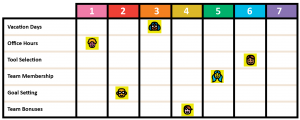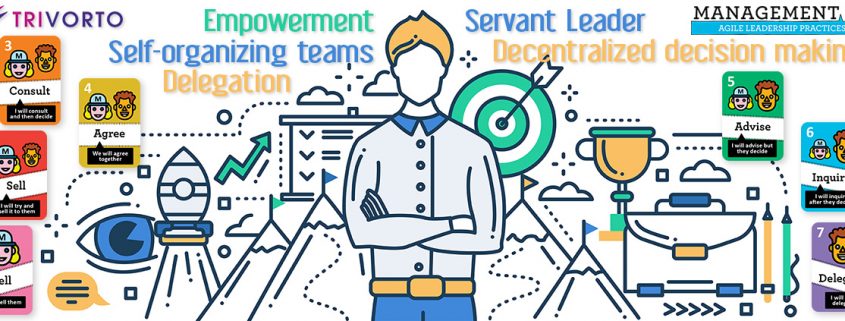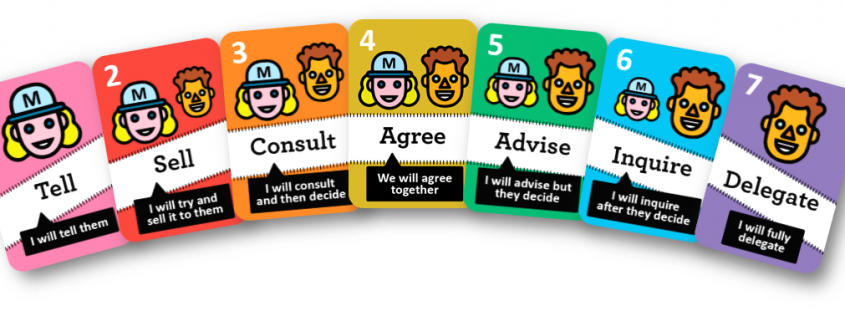Employee Empowerment demystified Part 2
Empowerment and delegation are management practices that are gaining popularity. However they proof to be hard to implement. In part 1 of this article we explored some of the principles behind delegation and empowerment that help you explain what can go wrong and why it takes time. Next we are going to look at a practical tool from the Management 3.0 toolkit that helps implementing delegation.
Management 3.0 defines seven levels of delegation. The delegation levels and a delegation board help implementing empowerment following the principles we discussed in the first part of this article. Having multiple levels of delegation makes sense. When setting constraints you will find that for some decision areas different levels of delegation are appropriate. The seven levels are:
- Tell: You as manager make the decision and you inform others of the decision made. This is obviously the lowest level of delegation. Actually it not delegation at all, but there will be areas where you just cannot delegate decision making.
- Sell: You make the decision but you do try to convince others it is the right decision.
- Consult: You ask for input, and then make a decision taking the input into account.
- Agree: You try to reach consensus as a group on the right decision.
- Advise: You offer your opinion but it is their decision to make.
- Inquire: They make the decision but you do want to be informed.
- Delegate: They make the decision and you don’t even have to know what it is.
The first step is to identify areas of decision making. Be as specific as possible. Don’t do this on your own, do it together with the people you are delegating decisions to. It is ok to prepare a preliminary list of course but don’t fall into the trap of unconsciously choosing the lowest level of delegation for… implementing delegation.
The second step is to go by each decision area and agree on the appropriate delegation level. It is ok to be clear that some topics will have a lower level of delegation for now, after all you are setting constraints. People understand you won’t be leaving everything up to them. Don’t forget the reflexive principle: team members might not feel comfortable with a high delegation level at some areas, even if you feel confident they can do it.
Management 3.0 has nice sets of cards available that represent the delegation levels. You can use these just to make things more visual: it has more impact to point to a card than to say ‘level 4’. You can also use the cards to play Delegation Poker, a derivative of the Agile estimation technique Planning Poker.
 The Delegation Board is the final step: it is the visual result of the agreements made. The Delegation Board is a grid that displays all decision areas as rows and the 7 delegation levels as columns. It marks the delegation level for each decision area. Being transparent on the agreed delegation levels is crucial.
The Delegation Board is the final step: it is the visual result of the agreements made. The Delegation Board is a grid that displays all decision areas as rows and the 7 delegation levels as columns. It marks the delegation level for each decision area. Being transparent on the agreed delegation levels is crucial.
An example of the use of the delegation board is a manager who had two goals: the first was to increase the level of responsibility of the team leaders in her group. The second one was a very practical one: to reduce her workload caused by the company policies requiring her to approve everything. She was involved in a lot of processes and decisions of which she felt her added value was limited. The team leaders could very well decide themselves.
You can use the delegation levels the other way around as well. The same manager was in a new role. The boundaries of her authority were blurred. She sometimes felt a lack of authority in areas she would have expected otherwise. Clearly the organization still needed to get used to the new role. In such a situation you can also use the delegation levels to clarify constraints upwards: discuss delegation levels on key decision areas with your manager.
Do you want to learn more about modern management? Attend one of our Management 3.0: Modern Leadership Practices classes.


